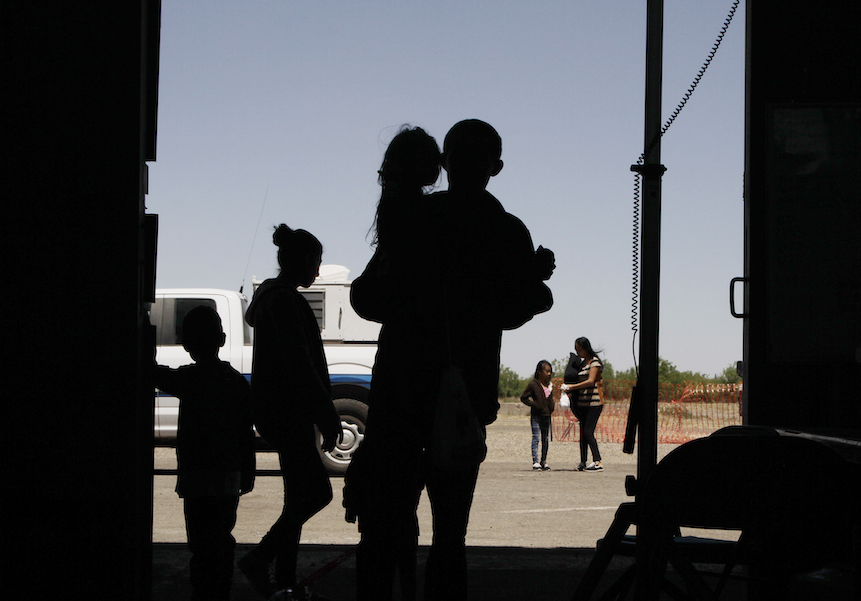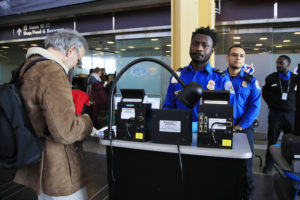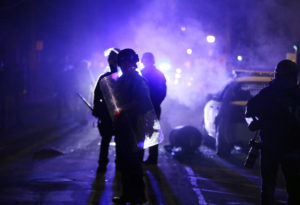Trump Administration Moves to End Limits on Child Detention
A court fight will almost certainly follow over the government's desire to hold migrant families until their cases are decided. Immigrants guide their children through the entrance of a World War II-era bomber hangar in Deming, N.M. (Cedar Attanasio / AP)
Immigrants guide their children through the entrance of a World War II-era bomber hangar in Deming, N.M. (Cedar Attanasio / AP)
WASHINGTON—The Trump administration is moving to end a long-standing federal agreement that limits how long immigrant children can be kept in detention. A court fight will almost certainly follow over the government’s desire to hold migrant families until their cases are decided.
The current court agreement now requires the government to keep children in the least restrictive setting and to release them as quickly as possible, generally after 20 days in detention.
Homeland Security officials say they are adopting their own regulations that reflect the court’s “Flores agreement,” which has been in effect since 1997, and there is no longer a need for court involvement, which was only meant to be temporary. But the new rules would allow the government to hold families in detention much longer than 20 days.
It is the latest effort by the administration to tighten immigration, President Donald Trump’s signature issue, and is aimed at restricting the movement of asylum seekers in the country and deterring more migrants from crossing the border. The news immediately generated fresh outrage, following reports of dire conditions in detention facilities, and it is questionable whether courts will let the administration move forward with the policy.
Immigrant advocates decried the move and said prolonged detention would traumatize immigrant children.
“The government should not be jailing kids, and certainly shouldn’t be seeking to put more kids in jail for longer,” Madhuri Grewal, policy counsel for the American Civil Liberties Union, said in a statement.
Peter Schey, a lawyer for the immigrant children in the Flores case and president of the Center for Human Rights and Constitutional Law, said if the regulations don’t match the settlement in that case, “they would be in immediate material breach, if not contempt of court.”
“I think all these things are now part of the 2020 campaign,” Schey said.
Acting Homeland Security Secretary Kevin McAleenan said Wednesday the regulations create higher standards to govern family detention facilities. The facilities will be regularly audited, and the audits made public.
The regulations are expected to be formally published Friday and go into effect in 60 days absent legal challenges.
They follow moves last week to broaden the definition of a “public charge” to include immigrants on public assistance, potentially denying green cards to more immigrants. There was also a recent effort to effectively end asylum altogether at the southern border.
The Flores agreement is a constant talking point by the president and his administration, which claims it is a loophole that encourages migrants to make a dangerous and potentially deadly journey to the U.S. The district judge overseeing the agreement has already refused government requests to increase the amount of time children can be detained, and advocates moved to block the regulations when the proposed rule was first announced last September.
There has been a drastic increase in the number of families crossing the border — about 475,000 so far this budget year, nearly three times the previous full-year record for families. Most are released into the U.S. while their asylum requests wind through the courts — a practice Trump has derided as “catch-and-release.”
The Flores agreement has been into effect since 1997 but mostly applied to children who came to the country alone. In 2015, U.S. District Court Judge Dolly Ghee ruled the requirements were applicable to children who crossed the border with families, after the Obama administration built family detention centers and started detaining families until their cases were completed.
Part of the issue was that children could not be kept in facilities that weren’t licensed, and no states license family detention centers. Homeland Security officials say by adopting the standards for education, healthy food and cleanliness used by U.S. Immigration and Customs Enforcement, which detains adult immigrants, they are satisfying requirements in lieu of state licensing requirements.
Homeland Security did not say how long it expects families to be kept, but McAleenan said under the previous administration it was about 50 days.
McAleenan said there was “no intent to hold families for a long period of time. The intent is for a fair and expeditious proceeding.”
Asylum cases involving detained families move much more quickly than cases for families released, taking months instead of years to resolve, in part because there are none of the delays that result when immigrants fail to show up for hearings.
The government operates three family detention centers that can hold a total of about 3,000 people. One is being used for single adults, and the other two are at capacity.
McAleenan said he didn’t expect to need more bed space because, together with other efforts to restrict the flow of migrants, he expects fewer people to be coming.
The massive influx of Central American families to the U.S.-Mexico border has vastly strained the system and foiled Trump’s tough talk on immigration, though agreements by Mexico to clamp down on migrants heading north and a new agreement with Guatemala forcing migrants to claim asylum there instead of heading north are expected to reduce the flow.
Trump administration officials have also forced more than 30,000 people to wait out their asylum cases in Mexico. It’s not clear how this change would affect that policy.
The Flores agreement governs more than just how long children can be held in detention, it sets standards of care for children who cross the border alone as well as with families. And lawyers in the case recently spoke out about what they said were deplorable, filthy conditions for children held at border facilities not meant to hold large groups of people for very long.
A report this week by the independent monitor overseeing claims of government noncompliance with Flores rules detailed the extreme overcrowding and poor conditions that immigrant youths faced in detention.
For example, a Border Patrol station in in Clint, Texas, an El Paso suburb, had a stated capacity for 105 children. On June 1, there were 676. Lawyers who visited in June described squalid conditions. Children cared for toddlers, the lawyers said, with inadequate food, water and sanitation.
At a detention center in McAllen, Texas, there were nearly 1,800 juveniles when the entire capacity for both juveniles and adults was 1,500.
The monitor in the Flores settlement visited some facilities, finding that they were as cold as 66 degrees Fahrenheit (19 degrees Celsius), and “even participants in the inspection and dressed in business clothes often found the temperature uncomfortably cool.”
A federal appeals panel found last week that detained children should get edible food, clean water, soap and toothpaste under the agreement, after a bid to limit what must be provided.
Flores surfaced again in the spring of 2018, when the Trump administration adopted a policy of prosecuting anyone caught crossing illegally. More than 2,900 children were separated from their parents as a result and sent to prison.
Trump eventually backed down and stopped the separation of families. A federal judge ruled children could not be separated from their parents, so immigration officials can’t send adults to immigration detention without their children, and can’t hold families longer than 20 days, which McAleenan and others have said is giving smugglers an opportunity to sell trips north.
___
Amy Taxin reported from Santa Ana, California. AP Writer Astrid Galvan in Phoenix contributed.
Your support matters…Independent journalism is under threat and overshadowed by heavily funded mainstream media.
You can help level the playing field. Become a member.
Your tax-deductible contribution keeps us digging beneath the headlines to give you thought-provoking, investigative reporting and analysis that unearths what's really happening- without compromise.
Give today to support our courageous, independent journalists.






You need to be a supporter to comment.
There are currently no responses to this article.
Be the first to respond.